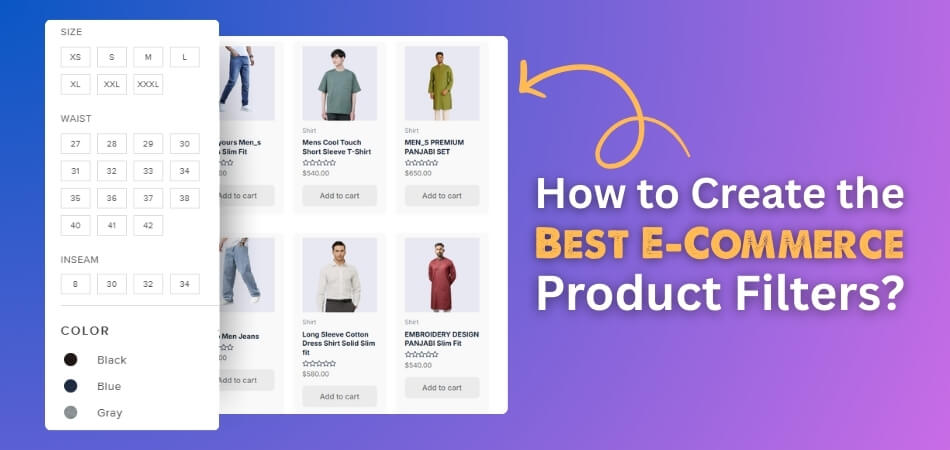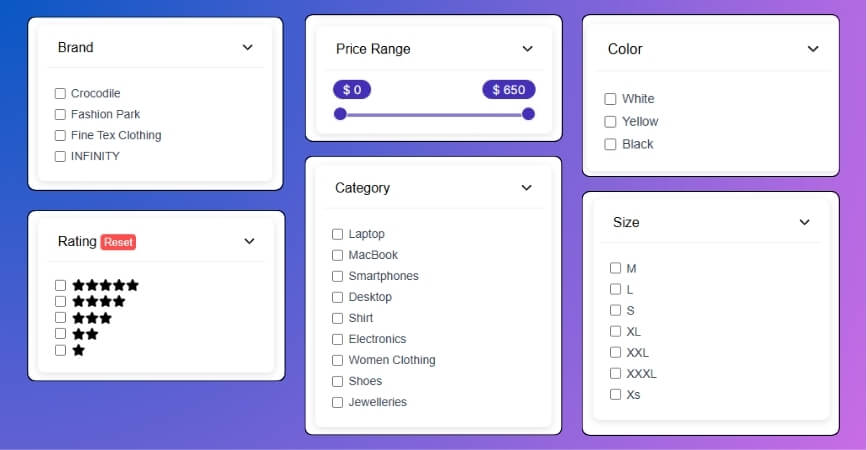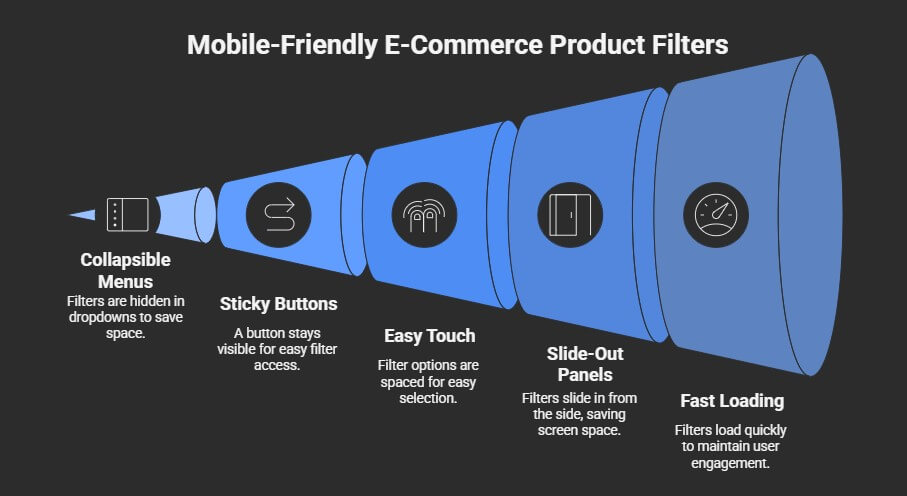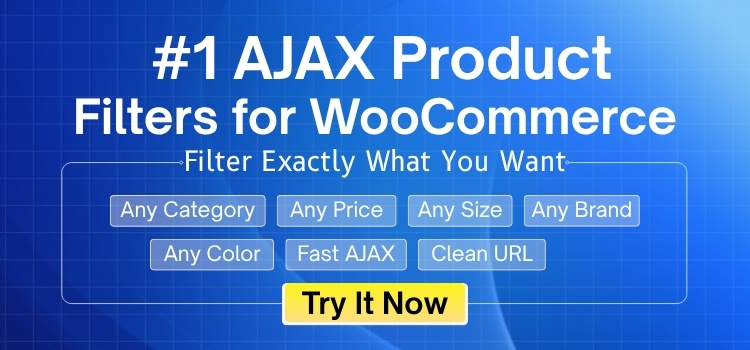E-commerce product filters play a big role in how easy and fast shopping feels on any online store. They help people find exactly what they want without getting lost in a long list of products. If you’ve been wondering how to make them work better, you might be thinking about how to create the best e-commerce product filters?
Create the best e-commerce product filters by using relevant types like size, price, and color, placing them clearly, allowing multi-select, showing selected filters, and making them mobile-friendly. Use visuals, keep layouts clean, and test filter performance often for best results.
Do you want to know what makes filters really work and what to include for the best results? If yes, keep reading—this article has all the helpful tips you need to improve product filters and make online shopping easier for everyone.
How to Create the Best E-Commerce Product Filters?
Shopping online is fun, but only if you find things fast. When filters are confusing, people leave without buying anything at all. The right product filters make online stores easier to use and shop from. Let’s check out the best ways to make product filters work better.

Filter Types
Shoppers look for things they care about, like price or size. These types of filters help narrow down choices and save time. Always use filters that match your product types and categories. For clothes, offer size, color, and fabric; for phones, screen size, and battery. The more helpful your filters, the happier your shoppers will be. Use clear words so people understand every option quickly. Helpful filters lead to more clicks and more sales.
Filter Placement
Most people expect to see filters on the left side or top. These spots are easy to notice and simple to use quickly. If you hide filters at the bottom, many users won’t find them. Making filters visible right away makes your store feel easy and smart. Keep the layout clean, so filters don’t mix with other parts. The right placement leads to faster shopping and better product choices. Don’t make users search for filters.
Visual Filters
Pictures make filter choices feel easier and more fun to use. For example, a red color box is better than the word “red.” Showing small images for colors, styles, or patterns saves reading time. People can click faster when they see what they want clearly. Visual filters are useful for fashion, makeup, and even furniture. They look better and work better than text alone. Keep it simple, clean, and helpful with tiny image examples.
Filter Order
Putting the most-used filters at the top saves a lot of time. Shoppers often check the price or size first before anything else. Filters used often should never be hidden at the bottom by mistake. A good order makes shopping feel smoother and more organized every time. When filters are mixed up, users feel confused and slow down. Always test what filters people use most. Then arrange those filters where they’re seen right away.
Review Filters
People trust reviews when buying online, especially from new stores. Allowing filters by star ratings helps buyers choose faster and smarter. For example, shoppers might only want products rated four stars and higher. This helps remove bad products and keeps quality ones in front. Review filters are small but powerful tools for online stores. Make sure people can click and filter by stars easily. Good reviews plus good filters lead to better decisions.
Product Specs
Many products need special details like weight, size, or speed. These details are called product specifications and are useful when buying technical items. If you sell electronics, filters like screen size or battery life matter most. Adding these filters gives people control over what they want to see. It makes their choices easier and faster. Only show specs that matter for each product type. Don’t overload users with too many confusing terms or numbers.
Thematic Filters
Some people shop based on mood, season, or special events too. For example, “Holiday Gifts” or “Back to School” filters work really well. These filters help people find themed items quickly without too much searching. It’s smart to use them during sales, seasons, or celebrations. They also make your store feel fresh and exciting every time. Thematic filters can increase views on items people may not usually find. Keep them fun and relevant.
Keep It Simple
Too many filter options can confuse and slow down online shoppers. Always use only the most important and useful ones for each product. Clean filter sections make shopping feel smooth and stress-free every time. Don’t add extra filters just to fill the space or look big. Filters should guide people, not push them away from your page. If things feel light and simple, people enjoy their time more. Simple filters lead to quicker choices.
Logical Layout
Everything should be placed in a way that feels clear and simple. Group filters like color, size, or material together in neat sections. Don’t scatter them randomly, or people won’t know where to look next. Clean layouts help customers think less and shop more. Use space wisely so nothing feels messy or too tight. Filters should feel like part of the page, not a chore. Logical layouts always make filters easier to understand.
Smart Display
Too many filters shown at once can make your page look messy. Use dropdown menus or scroll boxes to save space on the screen. People can open what they need without seeing everything all the time. This keeps the page clean and easy to focus on products. Make sure nothing looks cramped or too full at once. A smart display improves the look and works better as well. Easy design helps people keep shopping longer.
Highlight Key Filters
Some filters are more useful and should be easy to spot quickly. Filters like “Free Shipping” or “Best Seller” help people choose faster. Highlight them using color, icons, or placing them near the top. This helps shoppers find them before clicking around too much. When people see these filters first, they make decisions faster. These highlighted filters often lead to more product views and sales. Don’t hide what matters most to your shoppers.
Mobile Friendly
Phones are used more for shopping, so filters must work well there. Big buttons, easy slides, and clear labels make filtering fast on phones. If users struggle on mobile, they may leave your site quickly. Keep menus simple and let people open filters with one tap. Don’t make them scroll too much or zoom to click. A mobile filter design should feel smooth and fast. Good mobile filters keep people coming back often.
Multiple Choices
Letting users pick more than one filter at once saves time. For example, someone might want both “Red” and “Black” shoes shown. Multi-select filters give more freedom to find just the right things. It’s also faster than turning filters on and off one by one. Most shoppers prefer this way of filtering. It feels more modern, easier, and user-friendly. Always make sure your filter system allows picking more than one.
Show Selected Filters
People need to see which filters they’ve already picked while shopping. Showing active filters helps them stay organized and in control. If they want to remove one, it should be easy and fast. Many online stores use smart tools like Ajax product filter for WooCommerce to do this. These filters update without refreshing the page, making things faster. A clean filter bar keeps everything clear. The whole shopping experience becomes smoother and better.
Good product filters make online shopping faster and more fun. They help people find what they want without any stress or delay. When filters are simple and useful, more people stay and buy. Always test your filters and keep improving the shopping experience.
Should You Use AJAX for E-Commerce Product Filtering?
Using AJAX for product filtering in e-commerce can make the user experience faster and smoother. When someone clicks on a filter, the page updates instantly without fully reloading. This keeps people focused and saves them time. It feels more modern and reduces the chance of users getting frustrated or leaving your site early.
However, there can be a few downsides when it comes to SEO and site performance. Since AJAX updates content without changing the page URL, search engines might miss some of your filtered pages. This can reduce how many product pages show up in search results. To avoid this, it’s important to use proper settings like pushState and crawlable URLs.
Another thing to think about is site speed and technical setup. AJAX filters need more JavaScript and proper coding, which can slow things down if not built right. If your website is not optimized, too many AJAX calls can create loading delays. So, while AJAX filtering is helpful, it must be done carefully for best results.
Why Smart Product Filtering is Essential for E-commerce Success?
People don’t like spending time browsing through hundreds of products online when shopping. They want to find the right item quickly and easily. That’s why how filters work on a website really matters. Let’s explore how smart filters can help.

Better User Experience
A good filter system makes shopping feel easy and smooth. It helps people find exactly what they want without getting lost on the site. When filters are simple and clear, users don’t get confused or bored. They feel more relaxed and focused. With smart filters, shopping online becomes much more fun. This kind of experience keeps people coming back again and again.
Faster Product Search
Smart filters cut down the time it takes to find products. Instead of going through every page, users can choose what they want using filters. This means they see only the items that match their needs. Faster results make the whole process feel better. People are more likely to stay and shop when they don’t waste time. Quick filters lead to quick results.
Higher Conversions
Finding what customers want quickly increases their likelihood of purchasing it. Smart filters guide people to the right products without confusion. That’s why they play a big role in increasing sales. Clear options help users feel confident about their choices. If a website feels simple and easy, people trust it more. This trust turns into more sales for the business.
Lower Bounce Rate
If filters are missing or confusing, people leave the site quickly. This is called a bounce, and it’s bad for business. But when filters work well, visitors stay longer. They enjoy clicking around because it doesn’t feel like hard work. Lower bounce rates mean the website is doing a good job. Smart filters are a big reason why people stay on a site.
Easy Decision Making
Choosing between lots of options can feel stressful. Smart filters remove that stress by showing only the best matches. People don’t have to guess or look through pages they don’t need. This helps them decide faster and with less effort. The easier it is to decide, the happier the shopper is. Smart filters make buying feel simple and right.
Smart product filters make online shopping faster, easier, and more enjoyable. They help people find the right things without wasting time or effort. When done right, they keep visitors happy and increase sales as well. Always use smart filters to improve your store experience.
Types of E-Commerce Product Filters You Should Include
When a person shops online, they usually have something specific in mind. Without helpful filters, finding that one item can feel like a chore. That’s why using the right product filters is so important. Let’s look at the most useful types of filters you should use.

Price Range
Most people shop with a budget in mind, so price filters are a must. They help users pick items they can afford without wasting time on things out of their range. These filters work best for electronics, clothes, or anything with wide price differences. For example, many store owners start by using simple category or price filters — it’s easy to add a basic filter in WooCommerce through built-in widgets or plugins, which can later be expanded based on store needs.
Brand
Some shoppers only trust certain brands and want to see only those. A brand filter helps them skip the rest and focus on what they know. This is very useful for electronics, makeup, and fashion websites. You can list popular brands first to save people time. When a product type has lots of brands, this filter becomes even more helpful. It builds trust and helps people make faster choices with less effort.
Color and Size
These filters matter most for fashion, home decor, and accessories. A person looking for a blue t-shirt or a large shoe size doesn’t want to see everything. They want to find what fits their style or body right away. Giving people color swatches or a clear size chart with filter options saves them time. These filters should always match the items listed, so customers don’t see wrong or missing choices.
Ratings
Product ratings help people decide what’s worth buying. If someone only wants top-rated items, they should be able to filter by stars. This type of filter works great for electronics, books, or anything with lots of reviews. It also builds trust because people feel safer picking something with good feedback. Make sure the ratings are easy to see and that the filter is clear. Even just showing four stars and up can help a lot.
Categories and Stock
People can stay focused when there are many types of products in a store. Whether it’s shoes, phones, or books, users should be able to pick the type first. Stock filters also help by letting users hide out-of-stock items. No one likes clicking on something only to find it’s not available. These filters are very useful for saving time and keeping shopping frustration low. They make the whole store feel better organized.
Smart filters make it easier for people to find what they need faster. Each filter helps improve the shopping experience in its own way. When filters are simple and helpful, more visitors become happy buyers. Use the right mix of filters to grow your store better.
Tips to Make E-Commerce Product Filters Mobile-Friendly
People use their phones for online shopping more than ever these days. That’s why your filters must work well on smaller screens. If they don’t, customers might leave without even looking. Let’s explore how to make filters work better on mobile.

Use Collapsible Menus
Mobile screens don’t have much space, so filters shouldn’t take over the page. A great idea is to hide filters in dropdowns or collapsible sections. This way, people can tap to open what they need and skip what they don’t. It keeps the screen clean and simple to use. Some tools can even help you build this easily. Many store owners pick the best free filter plugin that supports mobile-friendly layouts like this right out of the box.
Add Sticky Buttons
One smart way to help mobile users is to show a sticky filter button. This small button stays on the screen as the person scrolls down. When they’re ready, they can tap it to open the filter panel quickly. It saves them from scrolling back up to find it. A sticky filter button feels helpful without getting in the way. Just make sure it’s small, clear, and easy to tap without blocking anything important.
Keep Touch Easy
Small buttons and tight spaces are hard to tap on a mobile. That’s why it’s important to leave enough space between each filter option. Bigger tap areas make it easier and faster for people to choose without mistakes. It’s also helpful to use checkboxes or toggles that are easy to press. Don’t forget to test your filters on different screen sizes to see how they feel. Easy touches mean less frustration and better shopping.
Let Filters Slide
Slide-out filter panels can make a big difference in phones. Instead of showing all filters on the page, let them slide in from the side. This gives people more space to shop while keeping filters close by. Once they pick their filters, they can slide the panel away. It feels simple and saves space. Many users like this design because it doesn’t take over the whole screen and keeps things neat.
Keep It Fast
Slow filters can ruin the shopping experience, especially on mobile networks. That’s why your filter system should work quickly without making the page reload every time. If filters load fast, people stay longer and look at more items. Don’t add too many heavy scripts that slow things down. Light, fast, and smooth filters make your store feel good to use. A quick tap should bring quick results without delay or errors.
Making filters work well on mobile is important for every online store. The better they perform, the longer people stay and shop. Use smart tools and simple layouts to improve the experience. Easy mobile filters lead to happy shoppers and more sales.
Commonly Asked Questions
You might have some questions when setting up product filters for your online store. From small technical steps to user-friendly design tips, these answers will help clear your doubts. Here are some helpful FAQs that can guide you further on this topic.
What Makes a Filter User-Friendly?
A user-friendly filter is simple to use and easy to understand. It should have clear labels that explain each choice without confusion. The layout should be clean, with enough space between options. Users should be able to find and use it without extra thinking.
How Many Filters Should I Add?
You don’t need to add every filter possible. Only include the ones that really help your customers find products faster. If there are too many, it may confuse people or slow them down. Focus on what makes sense for your product types.
Should Filters Be the Same on Every Page?
Not always, because different pages may need different filters. For example, shoe filters may show size and color, but laptop filters may show RAM and screen size. It’s better to match filters to the type of products shown. This way, filters stay useful and not confusing.
Can I Use Search with Filters?
Yes, filters work well with a search bar. A search bar lets users type what they want, and filters help narrow it down. Together, they make it easier to find the right product. This combo saves time and keeps people on your site longer.
Should Filters Work Instantly?
It’s best if filters update results right after a click. This feels quick and smooth to users. But make sure your site can handle it fast without getting slow. Instant updates help shoppers stay interested and avoid long waits.
How Can I Help First-Time Visitors?
For new visitors, keep your filters simple and clear. Use tooltips or short hints to explain some filters if needed. Place popular filters at the top to help them start quickly. Making it easy the first time keeps people coming back.
Is It Okay to Hide Some Filters?
Yes, hiding less-used filters under a “More Options” section is smart. This keeps the filter area clean and not too long. Users can still open them if needed. It helps focus on the most helpful filters first.
Do Filters Affect Website Speed?
Yes, filters that are too heavy or have bad coding can slow your site down. Try to use clean code and fast-loading scripts. Also, avoid reloading the full page if possible. Smooth filters make the site work better and feel modern.
End Note
Smart filters make online shopping smooth, fast, and more enjoyable for everyone. From simple price sliders to clear category filters, you now understand how to create the best e-commerce product filters. Keep it clean, simple, and always helpful for your users.
Before you launch your filter system, test everything on both desktop and mobile. Use filters that really match your products, keep them fast, and make sure they’re easy to use. Wishing you all the best in building a store that customers love to shop from!
